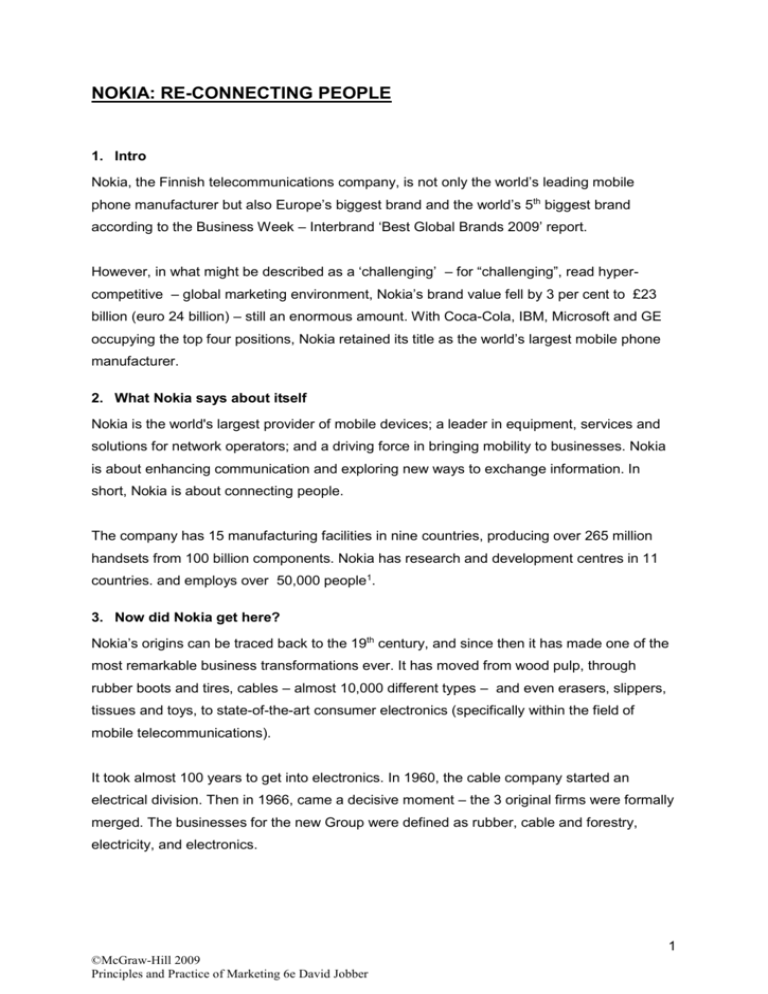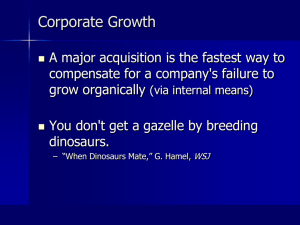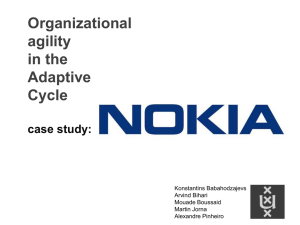Nokia Case Study Outline Notes
advertisement

NOKIA: RE-CONNECTING PEOPLE 1. Intro Nokia, the Finnish telecommunications company, is not only the world’s leading mobile phone manufacturer but also Europe’s biggest brand and the world’s 5th biggest brand according to the Business Week – Interbrand ‘Best Global Brands 2009’ report. However, in what might be described as a ‘challenging’ – for “challenging”, read hypercompetitive – global marketing environment, Nokia’s brand value fell by 3 per cent to £23 billion (euro 24 billion) – still an enormous amount. With Coca-Cola, IBM, Microsoft and GE occupying the top four positions, Nokia retained its title as the world’s largest mobile phone manufacturer. 2. What Nokia says about itself Nokia is the world's largest provider of mobile devices; a leader in equipment, services and solutions for network operators; and a driving force in bringing mobility to businesses. Nokia is about enhancing communication and exploring new ways to exchange information. In short, Nokia is about connecting people. The company has 15 manufacturing facilities in nine countries, producing over 265 million handsets from 100 billion components. Nokia has research and development centres in 11 countries. and employs over 50,000 people1. 3. Now did Nokia get here? Nokia’s origins can be traced back to the 19th century, and since then it has made one of the most remarkable business transformations ever. It has moved from wood pulp, through rubber boots and tires, cables – almost 10,000 different types – and even erasers, slippers, tissues and toys, to state-of-the-art consumer electronics (specifically within the field of mobile telecommunications). It took almost 100 years to get into electronics. In 1960, the cable company started an electrical division. Then in 1966, came a decisive moment – the 3 original firms were formally merged. The businesses for the new Group were defined as rubber, cable and forestry, electricity, and electronics. 1 ©McGraw-Hill 2009 Principles and Practice of Marketing 6e David Jobber Then, it was by no means certain that electronics would win out as the most important division within Nokia. The traditional businesses within the group could point to stability, longevity, market share and cash generation. And in the “new” business divisions, television manufacture was seen as a much better bet for quite a few years – in other words, the “safe” option. However, several factors were soon to make mobile communications not only a natural but also strategic choice and what might be described as a strategic window – a strategic opportunity where there’s a strong fit between the resources and capabilities of the organisation and an identified opportunity. 4. The pioneering ‘70’s – There might be gold in the sky At the start of the 1970s, the Nordic countries, who had already established a great degree of co-operation in various areas of trade, planned to have a common telephone network. No way, or so it was thought at the time, could Finland take the lead this enterprise. To put it bluntly, it had too small a population, and too many lakes, which ruled out interconnecting cables between the islands as far too expensive. The aerial route was the best, maybe the only solution, and so the NMT (Nordic Mobile Telephone) network idea was born, with Nokia appointed supplier of hardware. This enabled them to set future standards – potentially a huge market advantage. 5. The take-off ‘80’s – There’s definitely a market NMT, the world's first international cellular mobile telephone network, opened in Scandinavia in 1981 with Nokia introducing the first car phones for the network. In 1982, Nokia developed Europe's first digital telephone exchange, the DX 200. Since then, the company has had a hugely impressive track record of achievement. They claim the invention of the first car phone (the Mobira Talkman – 1984) and the first true portable and commercially available handset/phone (the Mobira Cityman – 1987 – a favourite of City Gents and Yuppies i.e. business people who were the market ‘innovators’ and ‘early adopters’ Nokia initially focused on). Other innovations introduced in the late ‘80’s included development of the world's first ISDN (Integrated Services Digital Network) exchange in 1998 and the world's first fast-poll 14,400 bps (bits-per-second) modem in 1989. 6. The manic ‘90’s – Reasons to be cheerful Nokia built on its successful pioneering and market development efforts as well as track record of innovation in the 1990s with milestones such as the development and launch of the 2 ©McGraw-Hill 2009 Principles and Practice of Marketing 6e David Jobber first potentially global mobile communications network – GSM (Global System for Mobile Communications) with the very first GSM call in 1991. GSM now has over 2 billion users in more than 200 countries worldwide2. It also introduced the both the Nokia 100 series, the first family of (hand) portable phones for all analogue networks and the Nokia 1011, the first digital (hand) portable phone for GSM networks (both 1992), the world's first SMSC (Short Message Service Centre) in 1993 and in the same year, the development and launch of the world's first credit card size cellular modem card, developed with AT&T Paradyne.3 Nokia’s strategic insight and corporate/commercial shift toward telecoms combined with its pioneering work within the area (as evidenced by its ‘Firsts’) meant that the company engineered its positioning to ensure that it was in the right place at the right time for the inevitable explosion of mobile telecommunications – the market definition of which is, to use Nokia’s strap-line, ‘Connecting People’. As for the market, business take up of the mobile communications technology continued apace in the early ‘90’s and in the mid to late ‘90’s there was an explosion in the consumer market as the technology became more widely available, more useful and much cheaper. And, as the market expanded, portability, design, style and services became much more important and segments of customers and consumers with different needs clearly emerged. Identifying these segments and developing value propositions which met each segments clearly defined needs, wants and desired was to be one of the key reasons why Nokia handsets became the handset of choice for the majority of users. The following graphics4 show this development. 3 ©McGraw-Hill 2009 Principles and Practice of Marketing 6e David Jobber Graphics: The Mobile Revolution - Dan Steinbock (Kogan Page 2005) As the chart below shows, exponential growth in volumes, revenues and profits, kicked in especially from 1990 to 2000 where volume totalled 78.5 million units (up 92% on the previous year’s volume), revenues reached almost £14.2 billion (€20.0 billion) and operating 4 ©McGraw-Hill 2009 Principles and Practice of Marketing 6e David Jobber profits of £2.8 billion (€3.9 billion) – a 57% increase over the previous year. The following table5 charts this remarkable rise. Graphic: Nokia ‘Towards Technology’ PDF available on Nokia web site 7. In the Millennium Doldrums From 2000, much to the surprise of the market, the Nokia bandwagon veered off the road – only slightly, at first, and then much more seriously. In August 2000, the value of the Nokia brand was deemed to be £21.9 billion (€30.7 billion), according to Interbrand. By 2004, the brand value had collapsed to £13.7 billion (€19.2 billion) – a reduction of 37.5%. However, although it had been obvious for some time that there was a problem, it was only in April 2004 that Nokia admitted that their sales were slowing. The reasons for this decline were various, some of which are listed below. They contain lessons for any company, especially market leaders like Nokia. Fixating on one competitor, at the expense of the others. When Microsoft announced their intention to enter the mobile phone market in 2004, all onboard systems at Nokia went into emergency mode. An article in the Economist in 2004 stated: “When a firm dominates a market, especially one that is driven by constant technological advances, it becomes so fixated with trying to ward off what it reckons to be its most powerful challenger, that it leaves itself vulnerable to attack from other directions”. Nokia seemed to ignore the challenges from other competitors (see below), and concentrated on Microsoft. Focusing on internal rather than market benefits. Nokia were guilty of taking their eyes off the market place, and failed to read and monitor 5 ©McGraw-Hill 2009 Principles and Practice of Marketing 6e David Jobber the growing demand for colour phones, inbuilt cameras and clamshell models (incredibly, Nokia was the only major player by 2004 not to have a clamshell). Other, smaller, hungrier, more market-focused competitors saw the way the market was going much more accurately. They built up value by offering the above features (with the attendant benefits) to the market. Nokia, on their own admission, focused on functional features like size and ease of use. They also restricted the range of their models, mainly to reap the rewards of manufacturing cost reduction. However, important segments of the market wanted more variation than Nokia was giving them. Reluctance to design and badge operator-specific handsets Because the market was rapidly maturing, competitors were eager to grab whatever market share they could. One of the ways to do this was to do deals with airtime providers, and agree to manufacture handsets specifically designed for them. For instance, Vodafone did a deal with Sharp, who designed and badged a handset just for them. Nokia believed that customers would stay loyal to handset makers, and paid less attention to their channel partners. Bad timing for carrying out major internal reorganisation Nokia implemented a huge reorganisation in late 2003. Obviously, one could say that any major reorganisation will cause some problems, but Jorma Ollila, Nokia CEO at the time, conceded that the timing of this one was wrong. It led to great upheaval in the company, and must have exacerbated the lack of focus on the marketplace. 8. The Turnaround Thankfully for Nokia, the sky brightened significantly between 2004 and 2006. Interbrand’s brand rankings, published in August 2006, reflected a rise in value 2005/6 of 14% (9th fastest grower) to just over £17.1 billion (€24.0 billion), 25% better than in the 2003/4 doldrums, and the accompanying report states6: “Nokia’s 14% turnaround in the ranking this year befits its position as the world’s #1 maker of cell phones. But market share is not the only factor that can be attributed to Nokia’s brand success. Taking a page from some of its competitors, Nokia has focused on design and ergonomics as a key differentiator. Smart brand architecture has kept focus clear with the company’s products divided into 4 divisions: mobile phones (wireless voice and data services for personal and business usage) multimedia (home satellite systems and mobile gaming devices) 6 ©McGraw-Hill 2009 Principles and Practice of Marketing 6e David Jobber networks (wireless switching and transmission equipment used in carrier networks) enterprise solutions (wireless systems for businesses). Nokia is no longer afraid to co-brand, seeking out important awareness and perception relationships with companies like Siemens. But they need to ensure the quality and benefits of these relationships, considering that one such coupling with Sanyo Electric was scrapped. Overall, the brand has definitely more cachet, with Nokia products and offerings now being extremely distinctive”. Among more recent initiates that were taken at that time were: “Nokia and Siemens announced a 50:50 joint venture last week that will see the merger of the groups’ fixed and mobile network infrastructure and services businesses. The newly formed entity is to be named Nokia Siemens Networks (NSN) and is targeting annual cost synergies of £1.07 billion (€1.5 billion) by 2010. It will position NSN within the top three players in the global networks industry. The group will sell “quadruple play” products that offer a combination of services including mobile and fixed-line telephony, internet access and television”. New designs based on segmentation variables such as benefits sought and lifestyle. Billions invested in research and development including some 600,000 users/consumers around the globe, as reported by Marketing Week on various occasions. The evidence - In quarter 2 of 2006 alone, Nokia shipped 78.4 million units (34% of total market) and sold over 3 million of its new ‘NSeries Multimedia Computers’. Its N93 will, in addition to allowing users to do the communications basics (handle calls and txt), also play music, shoot high-quality video, surf the Net, and has a fold-out 2.4-inch screen for watching TV and specially designed ‘mobisodes’ of our favourite soaps. Customer insight allowed it to develop sophisticated product/service/brand value propositions based on clever market segmentation and target market positioning initially based on technology, then lifestyle and then functionality/benefits sought. Mobile phones have moved from basic communications tools/devices to companions and extensions of our personalities and the emphasis is shifting from ears and mouth to eyes and fingers. 7 ©McGraw-Hill 2009 Principles and Practice of Marketing 6e David Jobber Successful segmentation, targeting and both competitive and customer/consumer positioning combined with the ability to offer differential advantages to profiled and significant market segments allowed Nokia to re-build and re-enforce its leading market position in mobile phones. 9. The Future Opinions vary about likely success in the future, as highlighted in the following article8: “Nokia is clearly committed to its traditional strategy, based on maintaining a large market share and the economies of scale which both accompany and support such a share. Nokia is, say critics, being pushed downmarket as its share of revenue declines and it becomes more reliant on low-end handsets. But, says Mr Kallasvuo of Nokia, “being strong at the low end does not preclude strength at the high end.” Nokia's breadth and agility enables it to ride out fluctuations in geographical demand and product mix. “ A specific criticism is the company’s lack of success in the growing smartphone market. Although Nokia make roughly four out of ten mobile phones sold, it has been losing out in the market for phones that can access the internet, send emails and download third-party applications. Although Nokia made the first smartphone back in 2005 – the Nseries – it lost its leadership to the iPhone and Blackberry smartphone ranges. Nokia held 47 % of this market in 2007, but this had fallen to 31% by the beginning of 2009. Whereas Nokia’s mobile phones have been praised for their robust construction and ease of use, its smartphones have lost out to the iPhone and Blackberry as they were more difficult to use and did not possess the cache of their rivals. Useful Web Addresses www.nokia.com www.nokia.co.uk http://www.interbrand.com/best_brands_2006.asp http://www.businessweek.com/magazine/content/06_32/b3996410.htm?chan=topStories_ssi _5 http://www.text.it/home.cfm http://www.mmaglobal.co.uk/ 8 ©McGraw-Hill 2009 Principles and Practice of Marketing 6e David Jobber References and sources 1. Nokia website: Nokia in Brief 2005 (published June 2006). 2. Wikipedia 3. Nokia website: Nokia Firsts 4. The Mobile Revolution - Dan Steinbock (Kogan Page 2005) 5. Nokia.com 1975 – 1999 turnover 6. Interbrand / Business Week: Best Global Brands 2006: published 1st August 2006 7. Sunday Times 25 June 2006 8. Economist 12 February 2005: “The giant in the palm of your hand” 9. Wray, R. (2009) Nokia turns to Android in battle of the smartphones, Guardian, 6 July, 22. 10. Ewing, J. (2009) Nokia: Bring on the employee rants, Business Week, 22 June, 50. 11. Interbrand/ Business Week (2009) 100 Best Global Brands, 28 September, 50 – 60. Questions 1. How did Nokia become the global mobile communications powerhouse it now is? 2. What do you think went wrong at Nokia in 2003/ 2004? Frame your answer using the relevant parts Jobber’s table of attributes of internally orientated businesses. 3. How might Nokia ensure it maintains market leadership, and how likely is this to happen? This case was prepared by Tony Rowe and Tony Lindley. Tony Rowe is Principal of Marketing Mentors. Tony Lindley is Managing Director of Tony Lindey Consultants Ltd, and Visiting Fellow in Marketing at Bradford University School of Management. It was updated by Professor David Jobber, University of Bradford School of Management 9 ©McGraw-Hill 2009 Principles and Practice of Marketing 6e David Jobber






